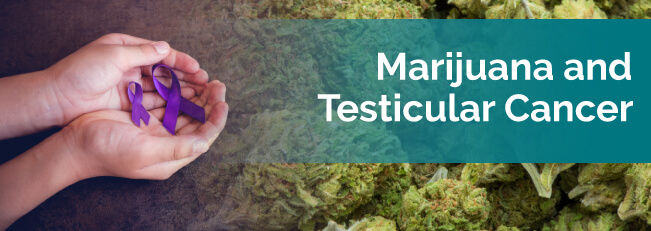
It’s impossible to overemphasize what an impact cancer has on anyone who has been diagnosed with the disease. When you have cancer, you can have some tough treatments that can cause severe side effects in addition to the cancer symptoms.
Testicular cancer is just one of the types of cancer that affects men and is quite common. Medical marijuana for testicular cancer can help ease the pain, nausea and other harsh side effects that come with pharmaceutical cancer treatments. And, with the increasing availability of refined and concentrated cannabinoid treatment options, patients can now find relief from this horrible disease.
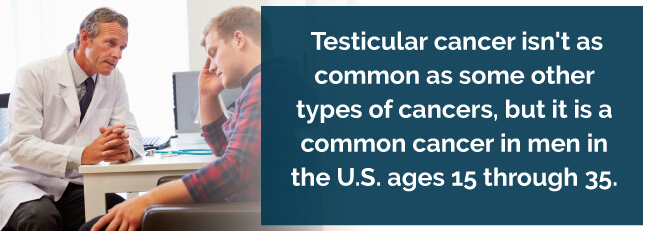
Men get testicular cancer in their testes (testicles). Their testes are located in the loose bag of skin called the scrotum that’s located underneath their penis. Testicles are responsible for producing the sex hormones in men and the sperm for reproduction. Testicular cancer isn’t as common as some other types of cancers, but it is a common cancer in men in the U.S. ages 15 through 35. This form of cancer is highly treatable and continues to be so even after it has spread past the man’s testicles. There are several treatment options, depending on the type and stage of your cancer.
A man’s testicles consist of various types of cells. Each of these cells can develop into different types of cancer. Since each cancer is treated differently and has a different prognosis, it’s important to determine which type you have. Read about the types of testicular cancer below.
Over 90 percent of testicular cancers develop in special cells called germ cells. These cells are the ones that produce sperm. Two primary types of germ cell tumors (GCTs) that can develop in men are:
Physicians can look under a microscope at the cells to determine what type you have.
These two types of GCTs occur about equally, and may contain both non-seminoma and seminoma cells. These mixed GCTs are treated as non-seminomas since they tend to grow and spread similar to non-seminomas.
Out of the two, seminomas usually grow and spread more gradually than non-seminomas. The two primary subtypes of these tumors are spermatocytic seminomas and typical, or classical, seminomas. Physicians can look under a microscope to tell them apart.
Some seminomas may increase human chorionic gonadotropin (HCG) protein blood levels. A simple blood test can detect HCG and doctors consider it a tumor marker for certain kinds of testicular cancer. Doctors can use it to give you a diagnosis or to see how you’re responding to your treatment.
These types of GCTs typically occur in men who are between their late teen years and in their early 30 years. There are four primary types of non-seminoma tumors known as:
Many tumors are a combination of different types. However, the treatment approach is somewhat similar with most non-seminoma cancers. Consult with your physician about the various types of testicular cancer, so you can receive a full explanation of the type you have.
Before the platinum combination chemotherapy era, radiation and chemo could cure testicular cancer in its earliest stages. But for patients who were in their advanced stages, it was almost uniformly fatal, according to the Journal of Clinical Oncology. The lack of accurate and convenient imaging techniques made managing it effectively more challenging.
Following the World War II years, radiation, orchiectomy with retroperitoneal lymph-node dissection (RPLND) or both were the most successful treatment options for testicular cancer regardless of histology.
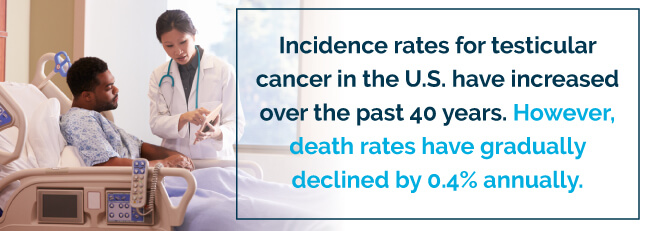
Incidence rates for testicular cancer in the U.S. have increased over the past 40 years. However, death rates for this type of cancer from 1990 to 2014 have gradually declined by 0.4 percent each year.
Testicular cancer signs and symptoms include discomfort or swelling in your scrotum. However, they could also be symptoms caused by another condition. Regardless, consult with your doctor if you’re experiencing any of the following symptoms:
You may also be dealing with many different emotions during or after your treatment. Many people go through this.
You might think about dying and death a lot. You may be more aware of how your cancer is affecting your friends, family and career. Your relationships with those around you may change. You may be concerned with things like having sex, dating or fathering children.
There may be unexpected problems that cause concern, such as the financial stress, that result from your treatment. Because you’re likely seeing your doctor and health care team less often once your treatments have concluded, you’ll have a lot more time to yourself. Having too much time without much to do can make some people anxious.
Having cancer can feel and get lonely. You shouldn’t try to handle everything yourself. And if you don’t include your family and friends, they may feel shut out. Let them in and let others in who are trying to help you.

According to the testicular cancer estimates by the American Cancer Society, in 2017 in the U.S.
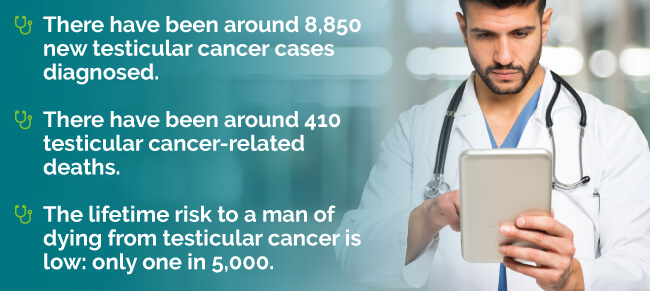
Testicular cancer statistics according to the US National Library of Medicine National Institutes of Health include:
The success rate of testicular cancer treatment is around 95 percent, meaning 95 percent of all patients with the cancer receiving treatment will make a complete recovery. The sooner the patient receives his diagnosis and receives treatment, the better prognosis he’ll have.
Treatment options for testicular cancer typically involve surgery, chemotherapy, radiotherapy or a combination.
Orchiectomy is usually the first treatment doctors try. Surgeons surgically remove the testicle to keep the tumor from spreading. Surgery may be all that’s needed if your diagnosis and treatment is stage one. During an orchiectomy, your surgeon will give you a general anesthetic. The surgeon makes a small incision in your groin and removes your testicle through this incision.
You’ll stay in the hospital for several days. If you still have one of your testicles left following your operation, this surgery shouldn’t affect your sex life and reproduction abilities.
If both testicles were removed, you’ll be infertile following the operation. You won’t be able to produce sperm. If you’re looking to have kids one day, you’ll want to consider banking your sperm before your operation, where your sperm is stored at a sperm-bank before the surgeon removes your testicles. Chemo and radiotherapy also affect your long-term fertility.
Side effects of an orchiectomy may include:
If your cancer has spread to your lymph nodes, a surgeon will have to remove them surgically. Typically, this involves your lymph nodes in your chest and abdomen. In some cases, this surgery may also lead to infertility. While serious complications are rare, they can happen. Around five to 10 percent of patients will experience temporary side effects, such as wound infections or bowel obstruction, following their surgery.
Chemo is a treatment option where the doctor prescribes medication containing chemicals that destroy cancer cells. Cytotoxic medication keeps the cancer cells from separating and growing.
You’ll typically receive chemo if you have an advanced stage of testicular cancer where it’s spread to other areas of your body. You’ll either take oral tablets by mouth or receive an injection. Unfortunately, chemo not only attacks cancerous cells but healthy cells too. Therefore, you’ll experience some temporary side effects that can be quite unpleasant such as:
You can experience unpleasant and uncomfortable side effects of chemotherapy. However, the ability for patients to manage these side effects has improved considerably. Medical marijuana can help with some of the side effects of chemotherapy, especially nausea and vomiting.
Radiation therapy is a procedure where the surgeon uses high-energy X-ray beams or particles to destroy your cancer cells. Radiotherapy damages the DNA that’s inside the tumor cells and destroys their reproduction ability. When you have seminoma testicular cancer, you’ll likely need radiation therapy along with surgery.
Radiation therapy also prevents the return of cancer. If your cancer has spread to your lymph nodes, you’ll most likely need this therapy.
Temporary side effects of radiotherapy include:
Although there’s a study that links marijuana to testicular cancer, it doesn’t make any definitive conclusions or show a cause-and-effect relationship. And there are handfuls of other studies showing that cannabis as testicular cancer treatment helps increase your appetite and reduces nausea and pain associated with chemotherapy.
University of East Anglia scientists have shown how marijuana’s main psychoactive ingredient can actually reduce the growth of tumors in cancer patients. Published research today shows the existence of earlier signaling platforms responsible for the success of the drug in shrinking tumors.
The hope is that the findings can help with the development of a synthetic equivalent that had anti-cancer properties. The scientists induced tumors in mice using samples of human breast cancer cells. They then dosed the tumors with THC, a cannabis compound. The scientists found there were a couple of cell receptors in particular that caused the anti-tumor effects of the drug.
THC acts through a specific cell receptor family known as cannabinoid receptors. However, the scientists couldn’t decipher which of the receptors caused THC’s anti-tumor effects. According to the scientists, the CB2 and GPR55 joint interaction mediated these effects. These are two compounds found in the cannabinoid receptor family. The scientists’ findings helped to explain the effects of THC at high and low doses on tumor growth.
Cannabinoids, the components in marijuana, could protect against certain kinds of cancer tumors, including those in the testes. In a two-year preclinical study, scientists investigated the effects of THC on rats and mice with tumors. They tube-fed the cannabinoid to the subjects in various doses observed the tumors.
The study found THC could reduce the incidence of both benign and cancerous tumors in places all over the body. Higher THC doses were linked with lower appearances of malignant liver cells. In other areas, like the uterus, mammary gland and pancreas, fewer benign tumors appeared. Benign tumors in the testes also occurred less.
Many experts think cannabis use could increase someone’s chances of getting cancer in their reproductive system. But, they have little quality evidence to back up this argument. If anything, the evidence we have so far only shows we need to do more research on the connection between cannabis and increased cancer rates.
Three studies examined the link between marijuana and testicular germ cell tumors (TGCTs), and each found a connection between marijuana use and an increased risk of TGCTs. But, none of these studies had large enough sample sizes to show the effects of different cannabis doses.
Medical cannabis for testicular cancer has proven to be extremely beneficial for improving patient’s well-being and often assists patients who are having adverse reactions to traditional medicine treatments like chemo and radiation. Marijuana also doesn’t have many of the side effects that both chemotherapy and radiation do, such as:
Testicular cancer is a specific type of cancer that tends to affect between 7,500 and 8,000 men each year. This is considered the most common type of cancer that is found in males between the ages of fifteen and forty years old. Thankfully, medical marijuana has been a proven treatment to reduce the symptoms of chemotherapy in cancer patients. Chemotherapy although the usual treatment for this type of cancer usually brings along the side effects that are not loved.
Medical marijuana alleviates symptoms of nausea, a symptom directly associated with receiving chemotherapy. It also helps increase appetite as a stimulant, as appetite loss is a major factor when undergoing chemotherapy. Another piece of exceptional news is that medical marijuana has been proven through clinical studies to slow the rate of cancer cell growth and eliminates the multiplying of these cells to kill them off.
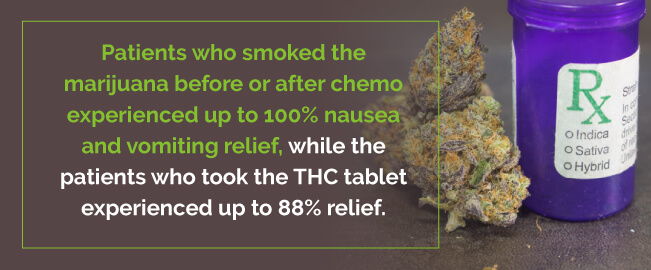
Other research included data collected on 748 patients who smoked cannabis before or after their chemo and 345 patients who took an oral THC tablet. The patients who smoked the marijuana experienced up to 100 percent nausea and vomiting relief, while the patients who took the THC tablet experienced up to 88 percent relief.
According to these studies, smoking cannabis is a very effective treatment for the side effects of chemo such as nausea and vomiting. However, smokeless inhalation devices would definitely reduce potential harmful effects of smoking medical pot.
Thankfully, there are marijuana strains available that are designed specifically to help patients experiencing the unpleasant and uncomfortable side effects listed above. Some cancer-fighting strains may include:
Of course, smoking cannabis is still the most common method of using the drug in the U.S. It’s the fastest way to get the beneficial chemicals of cannabis in your body. Using a glass pipe, rolling a joint or smoking out of a water pipe or a bong are traditional methods.
Smoking is an efficient and quick way to get an optimum dose of those effective cannabinoids into your system. You’ll feel the effects almost instantly, and once you reach your desired relief, you can simply stop smoking.
However, smoking does pose an increased risk of respiratory issues. Some other great methods of getting your marijuana treatment include:
To learn more about cannabis for testicular cancer and to find your perfect strain, search for a medical marijuana dispensary or doctor today. Here at Marijuana Doctors, we provide patients, including testicular cancer patients, transparency to select a doctor, set an appointment, and learn more about the benefits of medical marijuana.
Find A Doctor Find A Dispensary